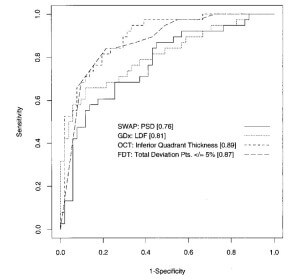Bowd C, Zangwill LM, Berry CC, Blumenthal EZ, Vasile C, Sanchez-Galeana C, Bosworth CF, Sample PA, Weinreb RN.
Invest Ophthalmol Vis Sci. 2001 Aug;42(9):1993-2003.
Glaucoma Center, Department of Ophthalmology, University of California San Diego, La Jolla 92093-0946, USA.
ABSTRACT:
PURPOSE: To compare the abilities of scanning laser polarimetry (SLP), optical coherence tomography (OCT), short-wavelength automated perimetry (SWAP), and frequency-doubling technology (FDT) perimetry to discriminate between healthy eyes and those with early glaucoma, classified based on standard automated perimetry (SAP) and optic disc appearance. To determine the agreement among instruments for classifying eyes as glaucomatous.
METHODS: One eye of each of 94 subjects was included. Healthy eyes (n = 38) had both normal-appearing optic discs and normal SAP results. Glaucoma by SAP (n = 42) required a repeatable abnormal result (glaucoma hemifield test [GHT] or corrected pattern standard deviation [CPSD] outside normal limits). Glaucoma by disc appearance (n = 51) was based on masked stereoscopic photograph evaluation. Receiver operating characteristic (ROC) curve areas, sensitivities, and specificities were calculated for each instrument separately for each diagnosis.
RESULTS: The largest area under the ROC curve was found for OCT inferior quadrant thickness (0.91 for diagnosis based on SAP, 0.89 for diagnosis based on disc appearance), followed by the FDT number of total deviation plot points of < or =5% (0.88 and 0.87, respectively), SLP linear discriminant function (0.79 and 0.81, respectively), and SWAP PSD (0.78 and 0.76, respectively). For diagnosis based on SAP, the ROC curve area was significantly larger for OCT than for SLP and SWAP. For diagnosis based on disc appearance, the ROC curve area was significantly larger for OCT than for SWAP. For both diagnostic criteria, at specificities of > or =90% and > or =70%, the most sensitive OCT parameter was more sensitive than the most sensitive SWAP and SLP parameters. For diagnosis based on SAP, the most sensitive FDT parameter was more sensitive than the most sensitive SLP parameter at specificities of > or =90% and > or =70% and was more sensitive than the most sensitive SWAP parameter at specificity of > or =70%. For diagnosis based on disc appearance at specificity of > or =90%, the most sensitive FDT parameter was more sensitive than the most sensitive SWAP and SLP parameters. At specificity > or = 90%, agreement among instruments for classifying eyes as glaucomatous was poor.
CONCLUSIONS: In general, areas under the ROC curve were largest (although not always significantly so) for OCT parameters, followed by FDT, SLP, and SWAP, regardless of the definition of glaucoma used. The most sensitive OCT and FDT parameters tended to be more sensitive than the most sensitive SWAP and SLP parameters at the specificities investigated, regardless of diagnostic criteria.
Figure from this article:


